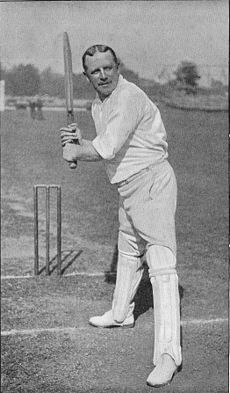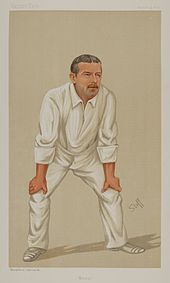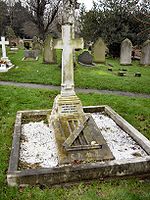- A. N. Hornby
-
AN Hornby 
Hornby in the 1890s Personal information Full name Albert Neilson Hornby Born 10 February 1847
Blackburn, Lancashire, EnglandDied 17 December 1925 (aged 78)
Nantwich, Cheshire, EnglandNickname "AN", "Monkey", "The Boss" Batting style Right-handed Bowling style Left or right arm, unknown style International information National side England Test debut (cap 15) 2 January 1879 v Australia Last Test 12 July 1884 v Australia Domestic team information Years Team 1867–1899 Lancashire Career statistics Competition Tests First-class Matches 3 437 Runs scored 21 16,109 Batting average 3.50 24.07 100s/50s 0/0 16/74 Top score 9 188 Balls bowled 28 593 Wickets 1 11 Bowling average 0.00 23.45 5 wickets in innings 0 0 10 wickets in match 0 0 Best bowling 1/0 4/40 Catches/stumpings 0/– 313/3 Source: CricketArchive, 22 September 2008 Albert Neilson Hornby, commonly designated A. N. Hornby, nicknamed Monkey Hornby (Blackburn, Lancashire, 10 February 1847 – 17 December 1925 in Nantwich, Cheshire) was one of the best known sportsmen in England during the nineteenth century excelling in both rugby and cricket. He was the first of only two men to captain the country at both rugby and cricket but is also remembered as the England cricket captain whose side lost the Test match which gave rise to the Ashes, at home against the Australians in 1882. Additionally, he played football for Blackburn Rovers.
Contents
Early life
He was the sixth son of William Henry Hornby, a cotton mill proprietor and director of the Lancashire & Yorkshire Railway who was Member of Parliament (MP) for Blackburn from 1857 to 1865. His brothers, Edward and William, were also MPs for Blackburn from 1869 to 1874, and from 1886 to 1910 respectively. Edward and another brother Cecil also played first-class cricket. Albert attended Harrow School and from there returned to Lancashire to join the family business.
Cricket career
Whilst at Harrow, his family had moved to Shrewbridge Hall, Nantwich, Cheshire, and he first played cricket for that county in 1862 and played in 20 matches between then and 1876. His club cricket was for the East Lancashire Club, Blackburn and he was first tried for Lancashire County Cricket Club in 1867. It was with his county that he was to play his finest cricket. He went on to play for Lancashire for 33 years, 17 as captain (in 1879–1893 and 1897–1898). For many years he provided an ideal attacking foil to the careful defence of his opening partner, Dick Barlow, with whom he was immortalised in one of the best known of all cricket poems, At Lord's by Francis Thompson which contains the following lines:
It is little I repair to the matches of the Southron folk,
Though my own red roses there may blow;
It is little I repair to the matches of the Southron folk,
Though the red roses crest the caps, I know.
For the field is full of shades as I near a shadowy coast,
And a ghostly batsman plays to the bowling of a ghost,
And I look through my tears on a soundless-clapping host
As the run stealers flicker to and fro,
To and fro:
O my Hornby and my Barlow long ago!His lack of stature and excess of energy earned him the nickname "Monkey" whilst at school and this stuck, while his players called him "The Boss", for his martinet approach to captaincy. In all cricket sources, however, he is referred to by his initials, and never by a nickname. His prowess as a forceful front-foot player, was matched by his fielding abilities. Between 1870 and 1881 he was the only player for Lancashire to reach a century for the club, which he did on seven occasions and in 1881 he topped the national averages, with his 1531 runs including three centuries.
Hornby was unable to carry his county form with the bat into the Test arena, his 3.50 average being a testament to this fact. In his debut Test on the 1878–79 Australian tour he lost his wicket in both innings to Spofforth and this was to be repeated in his next Test in 1882. The Test match in 1882 was a one-off game played at The Oval in London, England, and the English cricket team lost it to Australia by seven runs. In response, the Sporting Times printed the following "obituary" to English cricket:
In Affectionate Remembrance of ENGLISH CRICKET, which died at the Oval on 29th AUGUST, 1882, Deeply lamented by a large circle of sorrowing friends and acquaintances R.I.P. N.B. – The body will be cremated and the ashes taken to Australia.
Thus was born the greatest rivalry in cricket which to this day is known as The Ashes. AN Hornby captained England in only one more Test (his last), standing in for Lord Harris (who had stood out in protest) in the first Test of 1884. The match was played at Old Trafford on 10, 11 and 12 July 1884 and was drawn. Hornby avoided Spofforth but his 0 and 4 in the two innings remained undistinguished.
In addition to his county and country, he also played first-class cricket for Marylebone Cricket Club between 1873 and 1898. Aside from his playing for Lancashire, Hornby also held the posts of Lancashire Chairman from 1878 to 1898, and Lancashire President from 1894 to 1916.
AN Hornby Full name Albert Neilson Hornby Height 5ft 3 inches Weight six stone "bat and all" School Harrow School University Oxford University (briefly) Rugby union career Playing career Position three-quarter/full back Professional / senior clubs Years Club / team Caps (points) Manchester Football Club [1]
County side:
LancashireNational team(s) Years Club / team Caps (points) 1877–1882 England 9 Tries (1) Rugby career
Hornby first played for the Preston Grasshoppers and thence on to Manchester Football Club. His first game for England was on 5 February 1877 under the captaincy of Edward Kewley, a fellow Lancastrian. This match was the first 15-a-side international and was between England and Ireland at the Oval. He played as a three-quarter and despite being 30 years old, kept his place. He was present in the team in 1878 but due to his overseas international cricketing commitments in 1879 was unable to play rugby for his country that year. He was recalled to the side in 1880 as a full-back and it was in this position that he was called upon to captain his country in 1882. The game was played in Manchester on 4 March 1882 against Scotland who won by 2 tries to nil. When, later that year, Hornby led the England cricket team out at the Oval to play the Australians he became the first man to captain his country in both sports and this in his 36th year. He is one of only two men to have captained England at both these sports, the other being Andrew Stoddart.
Association Football
As well as becoming captain of the national side for both cricket and rugby, Hornby was also selected to play for Blackburn Rovers in their inaugural game at Alexandra Meadows, against Partick Thistle on 2 January 1878. He played for them in a few subsequent matches.
Personal life
In 1876 he married Ada Sarah Ingram, the daughter of Herbert Ingram MP, the founder and proprietor of The Illustrated London News. With Ada he lived in Church Minshull, Nantwich and they had four sons all of whom went to Harrow. George Vernon (1879–1905) died in South Africa, having served in the Boer War whilst Walter Ingram (1878–1918) died of wounds received in France. The youngest, John (1880–1927) was also wounded during the First World War and was awarded the Military Cross and later died when exploring in the north of Canada. The eldest son, Albert Henry (1877–1952) went on to Trinity College, Cambridge and like his father played and captained Lancashire. Between 1899–1914 he played 283 matches – only nine matches less than his father.
Hornby was also a Captain of 1st Royal Cheshire Militia. He died at Parkfield, Wardle, Nantwich, Cheshire, 17 December 1925.
See also
- History of Test cricket (to 1883)
- History of Test cricket (1884 to 1889)
References
- ^ Steve Lewis, One among Equals, page 159, 2008 (Vertical Editions:London)
External links
Sporting positions Preceded by
Alfred ShawEnglish national cricket captain
1882Succeeded by
Honourable Ivo BlighPreceded by
Charles GurdonEnglish National Rugby Union Captain
Mar 1882Succeeded by
Edward GurdonEnglish national rugby union team captains To 1900 1871-1873: Frederick Stokes • 1874: Alfred St. George Hamersley • 1875: Henry Arnold Lawrence • 1875-1876: Francis Luscombe • 1877-Mar 1878: Edward Kewley • Mar 1878: Murray Wyatt Marshall • 1879: Frank Reginald Adams • 1880-1881: Lennard Stokes • Feb 1882: Charles Gurdon • Mar 1882: A. N. Hornby • Dec 1882-1885: Edward Temple Gurdon • Jan-Feb 1886: Charles John Bruce Marriott • Mar 1886: Edward Temple Gurdon • 1887: Alan Rotherham • 1889: Fred Bonsor • Feb 1890: Andrew Stoddart • Mar 1890: John Lawrence Hickson • Mar 1890: Andrew Stoddart • 1891-Jan 1892: Frederic Alderson • Feb 1892: Sammy Woods • Mar 1892: Frederic Alderson • Jan 1893: Andrew Stoddart • Feb 1893: Sammy Woods • Mar 1893: Andrew Stoddart • Jan-Feb 1894: Richard Lockwood • Mar 1894: Ernest Taylor • 1895: Sammy Woods • 1896: Ernest Taylor • Mar 1896: Frank Mitchell • 1897: Ernest Taylor • 1898: J. F. Byrne • 1899: Arthur Rotherham •
To the First World War Jan 1900: Richard Cattell • 1900: John Daniell • Jan 1901: John Taylor • Feb-Mar 1901: William Bunting • Jan 1902: Harry Alexander • Feb-Mar 1902: John Daniell • Jan-Feb 1903: Bernard Oughtred • Mar 1903: Toggie Kendall • Jan 1904: Frank Moxon Stout • Feb-Mar 1904: John Daniell • Jan-Mar 1905: Frank Moxon Stout • Dec 1905 - Dec 1906: Vincent Cartwright • Jan 1907: Basil Alexander Hill • Feb 1907: John Green • Mar 1907: Ernest Roberts • Jan 1908: Thomas Kelly • Jan 1908: John Birkett • Feb 1908: Curly Hammond • Mar 1908: Lancelot Slocock • Jan 1909: George Lyon • Jan-Mar 1909: Robert Dibble • Jan-Feb 1910: Adrian Stoop • Mar 1910: Edgar Mobbs • Mar 1910-Feb 1911: John Birkett • Mar 1911: Anthony Gotley • Jan-Mar 1912: Robert Dibble • Apr 1912-Mar 1913: Norman Wodehouse • 1914: Ronald Poulton •
To the Second World War 1920: J. E. Greenwood • 1921: Dave Davies • Jan 1922: Bruno Brown • Feb 1922-1923: Dave Davies • 1924-1926: Wavell Wakefield • 1927: Leonard Corbett • 1928-Feb 1929: Ronald Cove-Smith • Mar 1929-Feb 1930: Joe Periton • Feb 1930-Jan 1931: Sam Tucker • Feb 1931: Peter Howard • Mar 1931-Jan 1933: Carl Aarvold • Feb-Mar 1933: Tony Novis • 1934: Bernard Gadney • Jan-Feb 1935: Douglas Kendrew • Mar 1935-Mar 1936: Bernard Gadney • 1937: Tuppy Owen-Smith • Jan-Feb 1938: Peter Cranmer • Mar 1938-Mar 1939: Henry Toft •
To the Professional Era Jan-Feb 1947: Joe Mycock • Mar-Apr 1947: Jack Heaton • Jan 1948: Edward Scott • Jan 1948: Tommy Kemp • Feb-Mar 1948: Edward Scott • Mar 1948: Bob Weighill • Jan-Feb 1949: Nim Hall • Feb 1949-Mar 1950: Ivor Preece • Jan 1951: Vic Roberts • Feb-Mar 1951: John Kendall-Carpenter • Jan 1952-Mar 1953: Nim Hall • 1954: Bob Stirling • Jan-Feb 1955: Nim Hall • Feb-Mar 1955: Peter Dalton Young • Jan 1956-Mar 1958: Eric Evans • 1959: Jeffrey Butterfield • 1960-1962: Dickie Jeeps • Jan-Mar 1963: Richard Sharp • May-Jun 1963: Mike Weston • Jan-Feb 1964: John Willcox • Feb-Mar 1964: Ron Jacobs • 1965: David Perry • 1966: Budge Rogers • Jan 1967: Richard Sharp • Feb-Nov 1967: Philip Judd • Jan-Feb 1968: Colin McFadyean • Feb-Mar 1968: Mike Weston • Feb 1969: Dick Greenwood • Feb-Apr 1969: Budge Rogers • Dec 1969-Mar 1970: Bob Hiller • Apr 1970: Bob Taylor • Jan 1971: Tony Bucknall • Feb 1971: John Spencer • Feb 1971: Bob Hiller • Mar-Apr 1971: John Spencer • Jan-Feb 1972: Bob Hiller • Feb-Mar 1972: Peter Dixon • Jun 1972-Mar 1974: John Pullin • Jan-Feb 1975: Fran Cotton • Mar-May 1975: Tony Neary • May 1975: John Pullin • Jan-Mar 1976: Tony Neary • 1977: Roger Uttley • 1978: Bill Beaumont • Feb 1979: Roger Uttley • Feb 1979-Jan 1982: Bill Beaumont • Feb 1982-Feb 1983: Steve Smith • Mar 1983: John Scott • Nov 1983-Mar 1984: Peter John Wheeler • Jun 1984: John Scott • Nov 1984: Nigel Melville • 1985: Paul Dodge • 1986: Nigel Melville • Feb-Mar 1987: Richard Hill • Apr 1987-Feb 1988: Mike Harrison • Mar 1988: Nigel Melville • Apr-Jun 1988: John Orwin • Jun 1988: Richard Harding • Nov 1988-Mar 1989: Will Carling • May 1989: Rob Andrew • Nov 1989-May 1995: Will Carling • May 1995: Rob Andrew • Jun 1995: Will Carling
To the Present Day Nov 1995-Mar 1996: Will Carling • Nov 1996: Phil de Glanville • Dec 1996: Jason Leonard • Feb-Jul 1997: Phil de Glanville • Nov 1997-Apr 1998: Lawrence Dallaglio • Jun 1998: Tony Diprose • Jun-Jul 1998: Matt Dawson • Nov 1998: Martin Johnson • Nov 1998-Apr 1999: Lawrence Dallaglio • Jun-Oct 1999: Martin Johnson • Feb-Apr 2000: Matt Dawson • Jun 2000-Apr 2001: Martin Johnson • Jun 2001: Kyran Bracken • Oct 2001: Matt Dawson • Nov 2001: Neil Back • Nov 2001-Mar 2002: Martin Johnson • Mar-Apr 2002: Neil Back • Jun 2002: Phil Vickery • Nov 2002-Feb 2003: Martin Johnson • Mar 2003: Jonny Wilkinson • Mar-Jun 2003: Martin Johnson • Aug 2003: Jason Leonard • Aug 2003: Dorian West • Sep-Oct 2003: Martin Johnson • Nov 2003: Phil Vickery • Nov 2003: Martin Johnson • Feb-Jun 2004: Lawrence Dallaglio • Nov 2004-Feb 2005: Jason Robinson • Mar 2005-Mar 2006: Martin Corry • Jun 2006: Patrick Sanderson • Nov 2006: Martin Corry • Feb 2007: Phil Vickery • Mar 2007: Mike Catt • May 2007: Jason Robinson • Jun 2007: Jonny Wilkinson • Aug 2007: Phil Vickery • Aug 2007: Mike Catt • Aug-Sep 2007: Phil Vickery • Sep 2007: Martin Corry • Oct 2007-Feb 2008: Phil Vickery • Feb 2008: Steve Borthwick • Feb-Mar 2008: Phil Vickery • Jun 2008-Mar 2010: Steve Borthwick • Mar 2010-Nov 2010: Lewis Moody • Nov 2010: Nick Easter • Nov 2010: Lewis Moody • Feb 2011: Mike Tindall • Aug 2011: Lewis Moody • Aug 2011-Sep 2011: Mike Tindall • Sep 2011: Lewis MoodyNote 1 • Sep 2011: Simon ShawNote 1 • Oct 2011: Lewis Moody
Notes Note 1: Lewis Moody was substituted in the England vs Georgia match on 18 September 2011, and Simon Shaw was confirmed as captain for the remainder of the match.
Categories:- 1847 births
- 1925 deaths
- England Test cricketers
- English cricket captains
- English cricketers
- Lancashire cricketers
- Lancashire cricket captains
- English rugby union players
- England international rugby union players
- Old Harrovians
- People from Blackburn
- Lancashire County RFU players
- United North of England Eleven cricketers
- Blackburn Rovers F.C. players
- Sportspeople of multiple sports
- Gentlemen cricketers
- Marylebone Cricket Club cricketers
Wikimedia Foundation. 2010.


